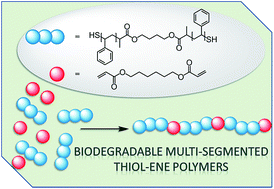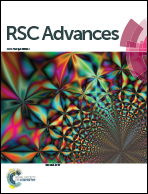Synthesis of degradable multi-segmented polymers via Michael-addition thiol–ene step-growth polymerization†
Abstract
A series of (bio)degradable multi-segmented poly(β-thioester) (PBT) linear polymers and networks are synthesized using bifunctional telechelic polystyrene (PS) and poly(iso-bornylacrylate) (PiBoA) precursor polymers, obtained via reversible addition fragmentation chain transfer polymerization. The thiocarbonyl thio end groups of the bifunctional RAFT precursors are converted into thiols via aminolysis with hexylamine. The obtained dithiol polymers are then used as Michael donors in a phosphine catalyzed thiol–ene step-growth polymerization, either with hexanediol diacrylate to yield linear polymers in which the diacrylate units are evenly spaced along the backbone, or with multifunctional acrylates to obtain cross-linked PBT networks with defined PS segment sizes. Aminolysis and thiol–ene Michael addition reactions can be performed in a one-pot procedure, but improved results are obtained when the polymeric thiols are first purified. The multi-segmented poly(β-thioester) polymers based on polystyrene precursors are characterized by means of TGA and DSC. The materials are thermally very stable and feature glass transition temperatures between polystyrene and pure PBTs. Further, the (bio)degradability of the materials (into the original low molecular weight PS segments) is demonstrated by basic or enzymatic hydrolysis of the labile ester bonds in the polymer backbone.


 Please wait while we load your content...
Please wait while we load your content...